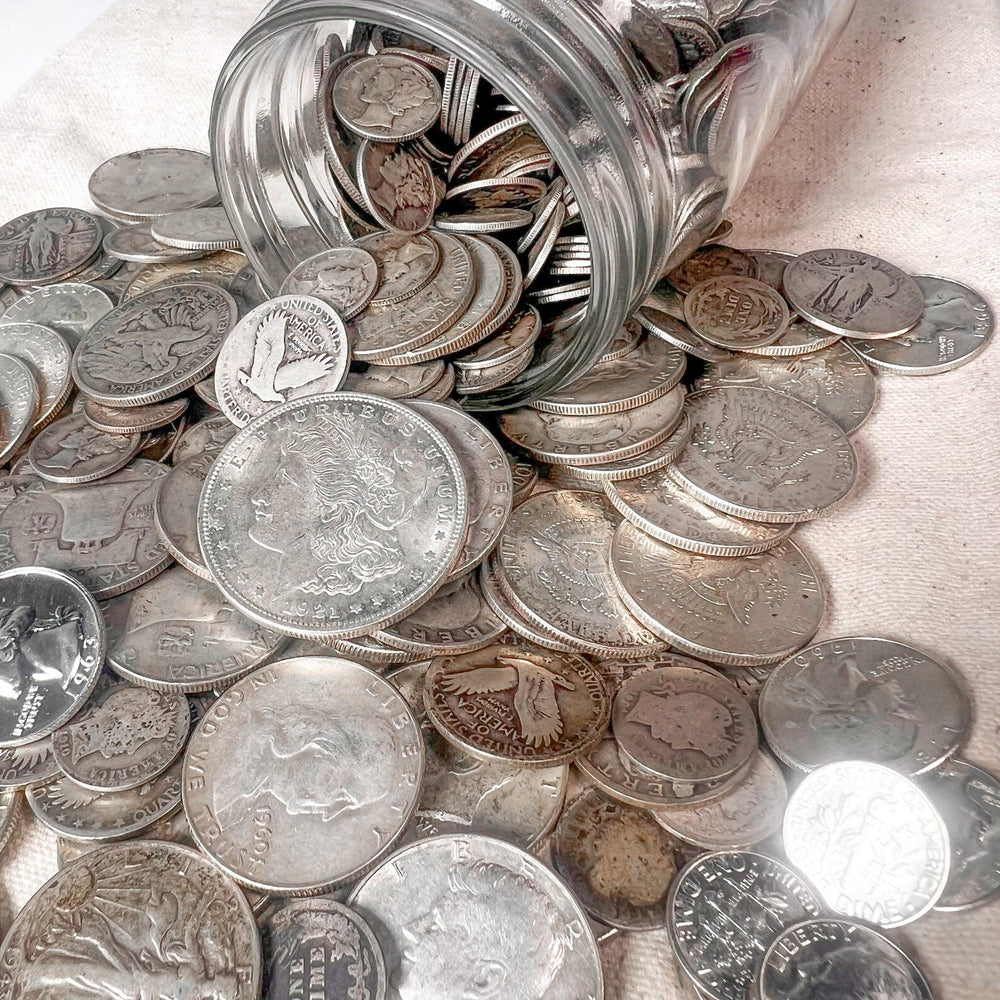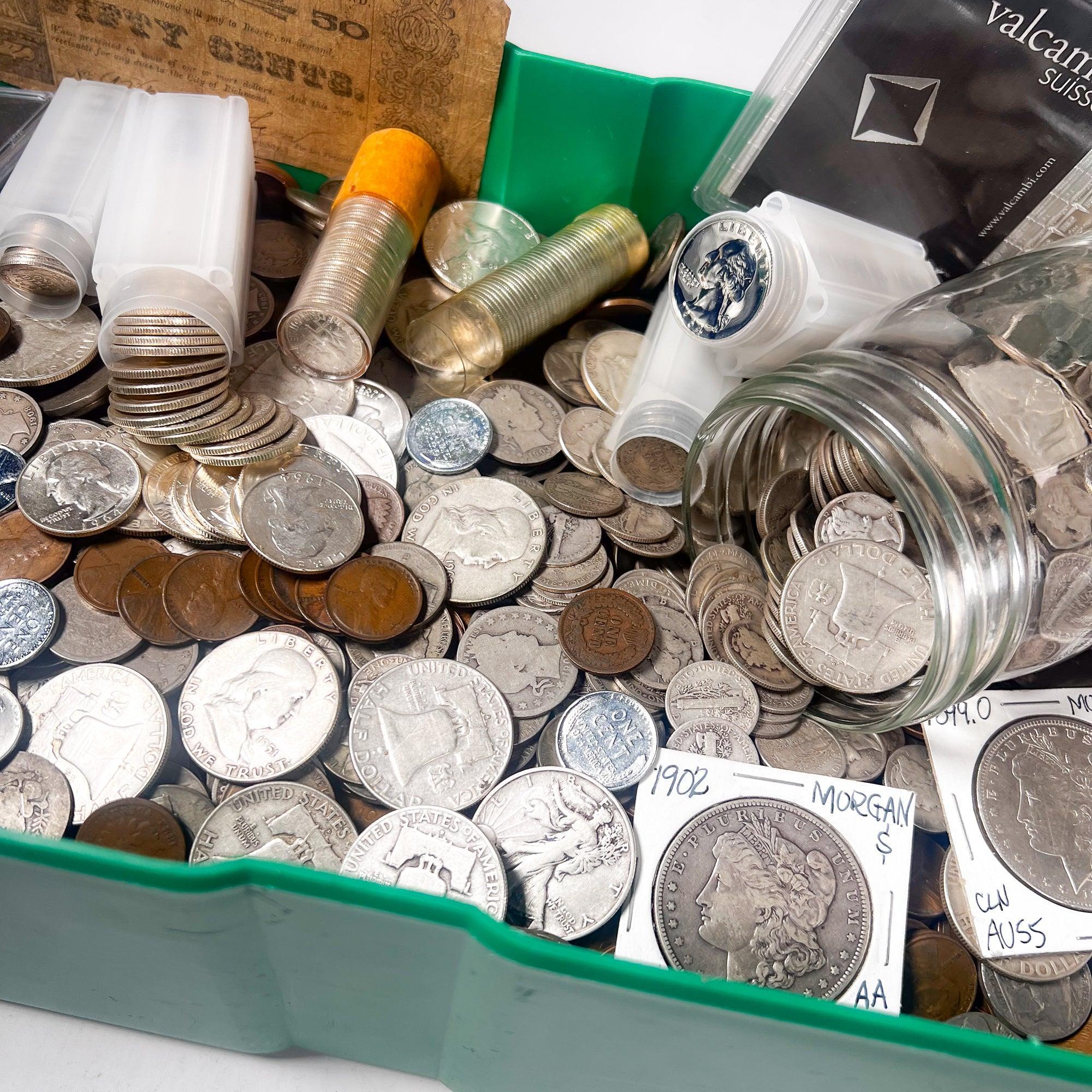Portfolio Power-Up: Strategic Integration of 90% Silver U.S. Coins into Your Investment Portfolio
In today’s volatile economic landscape, a resilient portfolio is key to weathering market storms and achieving long-term growth. Traditional stocks and bonds alone may not suffice, making tangible assets like 90% silver U.S. coins a powerful addition. These historic coins offer more than just silver—they blend intrinsic value, numismatic potential, and diversification benefits.
This guide, Portfolio Power-Up: Strategic Integration of 90% Silver U.S. Coins into Your Investment Portfolio, explores how to strategically incorporate these coins into your portfolio, leveraging their role as an inflation hedge and safe haven for wealth preservation and growth.
Why 90% Silver? The Strategic Case
With inflation, geopolitical uncertainty, and market volatility challenging the traditional 60/40 stock-bond portfolio, tangible assets like 90% silver U.S. coins shine. These coins, minted before 1965, combine the stability of precious metals with historical significance and potential numismatic upside. Unlike pure bullion, they offer a dual-purpose investment, making them a compelling choice for sophisticated investors seeking resilience and growth.
Key Benefits:
-
Inflation Hedge: Silver historically tracks or outperforms inflation.
-
Safe Haven: A buffer during market downturns or crises.
-
Numismatic Potential: Certain coins fetch premiums far above their silver value.
-
Liquidity & Divisibility: Small denominations enhance transaction flexibility.
Understanding 90% Silver U.S. Coins
What Is 90% Silver (Junk Silver)?
Known as "junk silver," these pre-1965 U.S. dimes, quarters, and half-dollars contain 90% silver and 10% copper. The Coinage Act of 1965 phased out silver in most denominations due to rising prices, with half-dollars fully transitioning by 1971. Each $1.00 face value holds approximately 0.715 troy ounces of pure silver.
Common Denominations:
-
Dimes (Mercury, Roosevelt): 0.0723 oz silver each.
-
Quarters (Standing Liberty, Washington): 0.1808 oz silver each.
-
Half-Dollars (Walking Liberty, Franklin, Kennedy 1964): 0.3617 oz silver each.
Melt Value Example (Spot Price $28.00/oz):
-
Dime: 0.0723 x $28.00 = $2.02
-
Quarter: 0.1808 x $28.00 = $5.06
-
Half-Dollar: 0.3617 x $28.00 = $10.13
Their fractional nature makes them ideal for small transactions or bartering, unlike large bullion bars.
Inflation Hedge & Safe Haven
Silver’s tangible nature protects against inflation and currency devaluation. During the 1970s inflation surge, silver prices soared, preserving purchasing power. As a safe haven, it stabilizes portfolios during market crashes or geopolitical turmoil, offering low correlation with stocks and bonds.
90% Silver vs. Other Silver Investments
-
Bullion Bars/Rounds: Lower premiums but no numismatic potential.
-
Modern Coins (e.g., Silver Eagles): Higher premiums, limited upside beyond initial cost.
-
Numismatic Rarities: High premiums, requiring specialized knowledge.
-
90% Silver: Balances low premiums with potential numismatic gains, plus high liquidity and recognition.
Strategic Portfolio Allocation
The Role of Precious Metals
Modern Portfolio Theory emphasizes diversification to reduce risk. Precious metals like silver have low or negative correlation with equities, stabilizing portfolios during downturns. The 2008 financial crisis highlighted their value, as silver and gold held firm while stocks plummeted.
Optimal Allocation
Financial experts often recommend 5–10% of a portfolio in precious metals, balancing hedging benefits with commodity volatility. Consider:
-
Risk Tolerance: Conservative investors may lean toward 10%.
-
Investment Horizon: Long-term investors benefit from silver’s inflation protection.
-
Economic Outlook: Increase exposure during inflationary or unstable periods.
Why 90% Silver?
90% silver coins offer cost-effective silver exposure with numismatic upside, unlike bars or high-premium coins. Their government-backed recognition ensures liquidity, making them a versatile portfolio component.
Maximizing Profitability: Targeting Numismatic Value
Beyond Melt Value
While most 90% silver trades near its melt value, certain coins command semi-numismatic premiums due to:
-
Rarity: Low mintage or surviving examples.
-
Mint Marks: Coins from Denver (D), San Francisco (S), or Carson City (CC).
-
Condition: Higher grades or strong strikes.
-
Full Strikes: E.g., Full Bands (Mercury Dimes), Full Head (Standing Liberty Quarters).
Key Coins to Target
Mercury Dimes (1916–1945)
-
1916-D: Ultra-rare (264,000 minted), $1,500+ in VF-20.
-
1921, 1921-D: Low mintages, high demand.
-
1942/1 Overdate: Valuable error coin.
-
Full Bands (FB): Boosts uncirculated value significantly.
Standing Liberty Quarters (1916–1930)
-
1916: Tiny mintage (52,000), worth thousands.
-
1917 Type 1: Rarer than Type 2.
-
Full Head (FH): E.g., 1929-S MS-64 FH ($1,000+).
Walking Liberty Half Dollars (1916–1947)
-
1921, 1921-D, 1921-S: Low mintages, valuable in all grades.
-
1938-D: Scarce series-ender.
-
Full Strike: Sharp details on Liberty’s hand and eagle’s feathers.
Franklin Half Dollars (1948–1963)
-
1953-P, 1953-S, 1961-P (FBL): Full Bell Lines add significant value.
-
Proofs: Rare and highly collectible.
Barber Coinage (1892–1916)
-
1894-S Dime: Ultra-rare, worth millions.
-
1901-S Quarter, 1892-O Half Dollar: Key dates with strong premiums.
Research Tools: Use the Red Book, NGC or PCGS population reports, and auction data from Heritage Auctions.
Sourcing Strategies
-
Reputable Dealers: Midwest Precious Metals Exchange offers authenticated 90% silver coins.
-
Coin Shows: Inspect and negotiate in person.
-
Online Platforms: Use trusted sites with clear return policies and authentication.
-
Due Diligence: Verify authenticity, check premiums over spot price (PVOP), and avoid counterfeits.
Practicalities of Ownership
Purchasing Best Practices
-
Dollar-Cost Averaging: Invest fixed amounts regularly to mitigate volatility.
-
Lump-Sum Purchases: Capitalize on price dips for larger buys.
-
Premiums Over Spot (PVOP): Monitor to buy when premiums are low.
-
Trusted Sources: Ensure secure payments and insured shipping.
Secure Storage
-
Home Safes: Use fire-rated, bolted safes for smaller holdings.
-
Bank Safe Deposit Boxes: Secure but limited by bank hours.
-
Third-Party Vaults: Professional, insured storage for large collections.
-
Preservation: Store in inert holders (e.g., Mylar flips, NGC/PCGS slabs) to prevent tarnishing.
Liquidity & Exit Strategies
-
Selling Options:
-
Dealers: Quick sales, slightly lower prices.
-
Online Marketplaces (e.g., eBay): Reach collectors, but factor in fees.
-
Auction Houses: Ideal for rare coins, with commissions.
-
Private Sales: Riskier but commission-free.
-
-
Maximize Returns: Sell during high-demand periods, use professional grading for numismatic coins, and monitor PVOP.
Long-Term Growth & Risk Management
Monitoring Market Trends
Track:
-
Industrial Demand: Silver’s use in tech and renewables.
-
Investment Demand: Driven by economic uncertainty.
-
Monetary Policy: Interest rates and quantitative easing.
-
Geopolitical Events: Boost safe-haven demand.
Tools: Monitor CPI/PPI for inflation signals and use Kitco for spot price updates.
Mitigating Risks
-
Volatility: Use dollar-cost averaging for stability.
-
Counterfeits: Buy from reputable sources like Midwest Precious Metals Exchange.
-
Storage Risks: Secure and insure holdings.
-
Liquidity: Plan for larger sales to avoid delays.
Portfolio Rebalancing
Regularly review your silver allocation to align with goals and market conditions. Increase exposure during inflationary periods or trim if silver becomes overweight.
Empower Your Portfolio
90% silver U.S. coins are more than bullion—they’re a bridge between wealth preservation and numismatic growth. By strategically integrating them into your portfolio, you harness their inflation-hedging power and potential for significant premiums. Start with trusted partners like Midwest Precious Metals Exchange, target key dates, and preserve your coins meticulously. Build a resilient, diversified portfolio ready for today’s economic challenges and tomorrow’s opportunities.
Disclaimer: Consult a financial advisor before investing. Silver prices and numismatic values are subject to market fluctuations.












